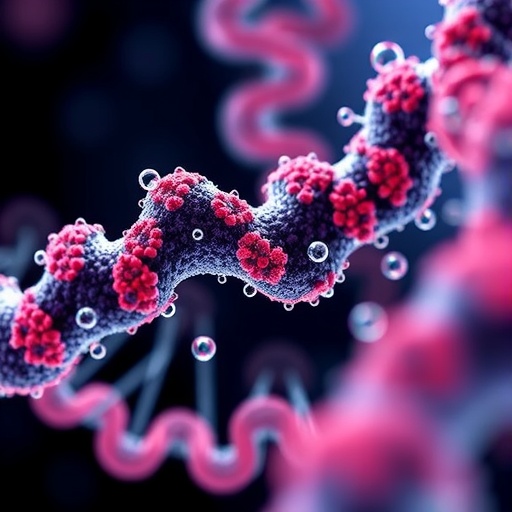Mitochondrial disorders represent a complex and multifaceted group of diseases rooted in the dysfunction of the mitochondrial respiratory chain (RC), an essential biochemical apparatus responsible for cellular energy production. Within this complex system, various protein complexes orchestrate the electron transport necessary for ATP synthesis. Among these complexes, Complex I (CI) stands as the largest and one of the most intricate, playing a pivotal role in cellular respiration. Recent advances have begun to unravel the genetic underpinnings associated with CI deficiencies, with new emphasis on the accessory subunit NDUFA3. This subunit, though historically considered auxiliary, is gaining recognition for its potential involvement in severe mitochondrial pathologies such as Leigh Syndrome.
Leigh Syndrome is a devastating neurodegenerative disorder predominantly seen in infancy or early childhood, characterized by progressive loss of mental and movement abilities. It stems from defects in mitochondrial energy metabolism, typically related to mutations affecting the components of the mitochondrial respiratory chain. Although numerous genes have been implicated in the etiology of Leigh Syndrome, the contribution of NDUFA3 variants is only beginning to surface in the scientific discourse. The study led by Sun et al. probes deeper into this connection, reporting novel variants of the NDUFA3 gene identified in a patient clinically diagnosed with mitochondrial dysfunction.
This investigation is significant because, despite the acknowledged association between NDUFA3 and Complex I, the functional consequences of mutations in this subunit remain enigmatic. Previous research has predominantly been descriptive, with limited genetic evidence characterizing these variants and no experimental data elucidating their mechanistic impact. Sun and colleagues venture beyond genetic sequencing, integrating biochemical assays and computational modeling to illuminate how these newly identified NDUFA3 mutations detrimentally affect mitochondrial function.
The research methodology employed is comprehensive, leveraging next-generation sequencing technologies to pinpoint novel NDUFA3 variants amid a backdrop of clinical signs indicative of mitochondrial disease. The patient’s biochemical profile reveals hallmark signs of Complex I impairment, including reduced enzymatic activity and altered substrate processing. These findings suggest a direct link between the identified genetic changes and the observed mitochondrial dysfunction, providing a compelling argument for the pathogenicity of the variants.
Delving into the molecular mechanics, the team utilizes structural bioinformatics to analyze how the NDUFA3 variants disrupt the assembly or stability of Complex I. The accessory subunit NDUFA3, though not directly involved in the catalytic core, contributes critically to the integrity and regulation of the entire complex. Mutations in NDUFA3 are hypothesized to induce conformational instabilities or interfere with protein-protein interactions essential for complex formation. The study’s findings lend robust support to this hypothesis, demonstrating altered Complex I architecture and compromised electron transfer efficiency.
What makes these revelations particularly impactful is the translational potential for mitochondrial medicine. Mitochondrial disorders have long been challenging to diagnose accurately due to their genetic heterogeneity and clinical overlap. Discovering novel pathogenic NDUFA3 mutations refines the genetic landscape associated with Leigh Syndrome and offers new diagnostic markers. Improved molecular diagnosis can foster earlier detection, enabling timely therapeutic interventions and better prognostic assessments for affected individuals.
Furthermore, the study underscores the necessity of functional analyses to complement genetic findings. Mere identification of variants without corroborative biochemical or structural validation risks misclassification of genetic changes as benign or uncertain significance. Sun et al.’s integrative approach exemplifies a gold standard in mitochondrial research, combining genotypic and phenotypic data to unravel disease mechanisms comprehensively.
Beyond diagnostic advancements, understanding the role of NDUFA3 variants opens avenues for targeted therapeutic development. Controlled manipulation of defective Complex I assembly or enhanced mitochondrial biogenesis could mitigate the bioenergetic deficits in cells harboring these mutations. Though therapeutic strategies targeting mitochondrial dysfunction remain largely experimental, foundational studies such as this one chart the course for future innovation.
The broader implications of this work extend into fundamental mitochondrial biology. Accessory subunits like NDUFA3, long overshadowed by the catalytic components, are revealing their crucial roles in maintaining the respiratory chain’s functional integrity. This shift in perspective challenges researchers to reevaluate mitochondrial complex architecture and dynamics, potentially revising textbook paradigms on oxidative phosphorylation regulation.
Moreover, the identification of NDUFA3’s involvement in a patient with mitochondrial disorders fortifies the clinical relevance of accessory subunits as bona fide targets of pathogenic variants. It compels both clinicians and researchers to consider these genes more routinely during diagnostic genetic screening, especially in unexplained mitochondrial phenotypes.
The manuscript not only adds to the mitochondrial disease puzzle but also highlights the sophisticated interplay between genetics, molecular biology, and clinical presentation. By bridging these domains, the study epitomizes the burgeoning era of precision medicine, where mutations in even seemingly minor components can illuminate profound pathological processes.
Importantly, such interdisciplinary work accentuates the value of integrating patient-derived data with cutting-edge laboratory techniques. The personalized identification of pathogenic variants strengthens the push towards individualized treatment approaches, moving away from one-size-fits-all regimens that have historically dominated mitochondrial disorder management.
Looking ahead, this research inspires further inquiry into the accessory subunits of mitochondrial complexes beyond NDUFA3. Elucidating their functional roles and contributions to various diseases may unveil novel biomarkers and therapeutic points of intervention. Comprehensive characterization of the mitochondrial proteome thus remains a vital frontier in the pursuit of overcoming mitochondrial pathologies.
In sum, the study by Sun and colleagues represents a breakthrough in uncovering the molecular pathology underpinning a rare form of mitochondrial disease. Their identification of novel NDUFA3 variants coupled with rigorous functional analyses deepens our understanding of Complex I functionality and the molecular genesis of Leigh Syndrome. This innovative research not only advances mitochondrial medicine but also exemplifies how meticulous scientific inquiry can unravel the intricate tapestry of human disease.
Subject of Research: Genetic and functional analysis of NDUFA3 variants in mitochondrial disorders
Article Title: Identification of novel NDUFA3 variants in a patient with mitochondrial disorders
Article References:
Sun, Y., Wei, X., Xiao, B. et al. Identification of novel NDUFA3 variants in a patient with mitochondrial disorders. Pediatr Res (2025). https://doi.org/10.1038/s41390-025-04403-4
Image Credits: AI Generated
DOI: https://doi.org/10.1038/s41390-025-04403-4




